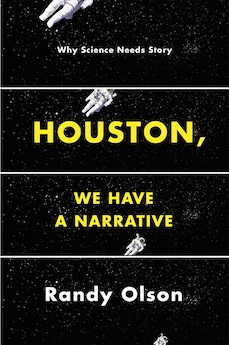By Sarah Gustafson
Houston, We have a Narrative is a study in effortless communication. Written in clear and persuasive prose, it argues that science must embrace the elements of story. Rather, scientists will make the case for themselves and their research stronger—in the popular press, in the minds of other scientists, in the eyes of funding organizations, and in the lay world at large—by adopting the same literary dynamics that turn scripts into Hollywood blockbusters. Drawing from experiences as a biologist, documentary filmmaker, and communications specialist, author Randy Olson stresses that scientific knowledge must resonate as meaningful… and consequently, that objective truth does not suffice.
This book is a delight to read. Part of what makes it so is Olson’s seamless blending of high and low culture—only appropriate since he makes the case that something “high” (science) must learn from the profit-driven techniques of the “low”: “It’s the people in Hollywood who have cracked the code of narrative over the past century, thanks to the driving force of financial profit. Science now needs their help.” He leverages Thomas Kuhn, Aristotle, Ptolemy, Hegelian dialectics, and various moments in the history of science (Galileo, Watson, Crick, Rosalind Franklin, and Thomas Dobzhansky, among others) as well as popular films and shows—Apollo 13, Schindler’s List, Star Trek, Star Wars, Pulp Fiction, The Wizard of Oz, South Park, among others. The title of this book is obviously taken from Apollo 13, and the story of the title offers instruction in just what Olson would have scientists do as communicators. Essentially, he is combatting what he describes as a popular notion among scientists that rigorously conducted research allows objective findings to stand alone. In other words, scientists hold dearly that the truth as they find speaks for itself. It is not incumbent on them to communicate it well or to infuse it with interpretation or meaning that allows others to better grasp its significance. That a Ben Affleck or Aaron Sorkin would hold themselves to the spirit of a truth rather than to truth, or to a narrative arc of storytelling rather than to the complexity of real life, is anathema.
Olson’s radical proposal to scientists is that they should exploit the same deep human responses to a particular type of communication—communication that does not rid itself of complex truths but streamlines them and packages them for the audience—that Hollywood exploits for billions of dollars a year. So, though the original statement astronaut Jack Swigert made in 1970 to NASA was “Houston, we’ve had a problem here,” Hollywood screen writers decided to revise it to “Houston, we have a problem.” Yes, it is not the original, but it is very close. Yes, it changes the urgency of the situation by shifting from past tense to present. Yes, it decreases the number of words. But the simplification of how a situation was communicated does not change the complexity of the situation. It does not change the underlying facts. It presents them in a more compelling way and makes us more invested in the story.
Olson does well to remind his readers that science, too, has a literature and a structure to its “storytelling,” otherwise known as the IMRAD: Introduction, Methods, Research, Analysis, and Discussion. He doesn’t propose a change in this, just a stylistic shift using a model called the ABT, otherwise known as the “DNA of storytelling”: And, But, Therefore. As distinguished from the lackluster AAA —And, And, And—the ABT doesn’t fall into the trap of knowledge presentation without theme or development. (Olson uses An Inconvenient Truth as a good example of AAA.) ABT makes even the most simplistic story, or most esoteric scientific research, into a journey into the unknown, with twists, turns, surprises, climaxes, endings, and, to use film lingo, the possibility of a sequel. Like the Hegelian dialectic, it moves us forward to a new horizon and makes the journey itself interesting. Simply incorporate this structure into an abstract or introduction, or use it in a presentation. No dramatic change to IMRAD necessary. And if you’re still not sure, he offers practical advice and appendices to help.
Olson provides a few examples from life of presentations and research paper abstracts he has helped colleagues transform from AAA to ABT. He doesn’t whitewash the negative reactions he received from those colleagues in response; he understands their deep disciplinary prejudices. But he also relays that once they did use ABT, they exceeded everyone’s expectations. As such, the book is by turns revolutionary and conciliatory. Houston, We Have a Narrative often feels like a conversation with a persuasive interlocutor than a guidebook. Olson models what he preaches, that “simplicity is the ultimate sophistication.” Although his proposal may be provocative to conservatives in the scientific disciplines, it seems to come from a place of kindness, humility, and passion. Olson asks scientists to do themselves a favor: learn from Hollywood experts to represent themselves as heroes on a quest for truth, and their work as stories worth telling, worth furthering, and especially worth funding.
Sarah Gustafson (ΦBK, Davidson College, 2014) has a master’s degree in history of political thought and intellectual history from University College London, where she won the Quentin Skinner Prize for her dissertation on Alexis de Tocqueville. Currently based at the American Enterprise Institute, she looks forward to her pursuit of a PhD in European and intellectual history.




